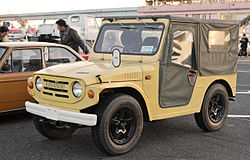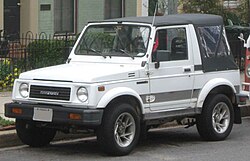The Suzuki Jimny is a successful line of SUVs from Suzuki. The line started in 1968 and is still running.
The Jimny8/LJ80 was an updated version of the LJ50 with an 800 cc, four-stroke, in-line four-cylinder engine, followed by the Jimny 1000/SJ410 and Jimny 1300/SJ413. An updated version of the SJ413 became known as the Samurai and was the first Suzuki officially marketed in the US. The series from SJ410 to SJ413 was known as the Sierra in Australia, and remained the Jimny in some markets.
The new Jimny was released in 1998, and now bears the same name in all markets. The 1998 release used the G13BB EFI engine, replaced by the M13AA EFI engine in 2001 and the M13AA VVT engine in 2005, in conjunction with a minor interior redesign.
The SJ-Series was introduced to the United States (Puerto RicoCanada earlier) in 1985 for the 1986 model year. It was priced at just $6200 and 47,000 were sold in its first year. The Samurai had a 1.3 liter, 63 hp (47 kW), 4-cylinder engine and was available as a convertible or a hardtop. The Suzuki Samurai became intensely popular within the serious 4WD community for its good off road performance and reliability compared to other 4WDs of the time. This is due to the fact that while very compact and light, it is a real 4WD vehicle equipped with a transfer case switchable 4WD and low range. Its lightness makes it a very nimble off roader less prone to sinking in softer ground than heavier ones. It is also considered a great beginner off-roader due to its simple design and ease of engine and suspension modifications. (SJ-410) and
The 1988.5 model Samurai was re-tuned for better on-road use in the United States. This revision included softer suspension settings and a larger anti-sway bar to reduce body roll. A lower 5th gear (.865:1 vs the earlier .795:1) increased engine rpm and power on the highway, and improved dashboard and seats made the Samurai more comfortable.
A new 1.3 4-cylinder engine with throttle-body fuel injection was introduced with 66 hp (49 kW) in September 1991. The Samurai was withdrawn in Canada in 1989 as the Suzuki Sidekick replaced it; however, sales in the United States market continued until 1995. Low sales prompted the withdrawal of the Samurai from the United States
The larger 1.3-litre Jimny was originally equipped with the G13BB engine also used in the JB32. The 80 hp G13BB engine was replaced in Japan with the January 2000 introduction of the newly designed VVT16-valve M-engine, but soldiered on in Spanish-built softtops until 2005. For the diesel loving continental European market, in 2004 the turbodies Jimny JB53 was introduced, built by Santana and using a Renault-built DDiS 1,461 cc K9K engine. Power was originally 65 hp but was increased to 86 hp in 2005, the same as in gasoline versions. It remains unavailable in Britain and Ireland.
Jimny features a part time 4WD system. On its dashboard, there are three buttons - 2WD, 4WD and 4WD-L. The 2WD is default when it runs as RWD. When 4WD is pressed, the front wheels are also engaged as drive with high gears. The 4WD-L engages front wheels as well as low ratio gears. Being a part time 4WD, there is no center differential or viscous coupling. The Jimny should not be driven on normal road surface in 4WD mode.
The Jimny's vacuum-locking hubs allow the vehicle to be shifted from 2WD to 4WD while travelling at up to 100 km/h (62 mph). Shifting to low range requires the vehicle to be stopped, but there is no need to exit the vehicle. Newer Jimnys feature electronic push-button selectable four-wheel drive.

The Jimny features large windows, giving excellent visibility, apart from a rather serious blind spot caused by the oversized "B" pillar. The large amount of glass also creates a greenhouse effect, and the Jimny comes with air conditioning as a standard feature in some regions.
In Europe, both Hard Top and Canvas Top versions come in JX and JLX specifications. These are fairly standard designations across the Suzuki off road range, with the JLX being the fully-optioned "luxury" version. In the case of the Jimny, the JLX adds roof rails, power steering, power windows, electronically adjustable exterior mirrors, and several interior comfort improvements. Both models are available with a 5 speed manual or 4 speed automatic gearbox. There is also a 2WD option, only available as a 5 speed manual.
As in Japan, Jimnys in Australia have borne the name Jimny SierraBogotá, Colombia.The Jimny is also available as a grey-import in Singapore since 2007, largely due to the Sierra name having become synonymous with small, capable off-road vehicles. Since 1999, GM Colmotores have been assembling the 1.3-litre, 79 hp (59 kW) JB33 with the name "Chevrolet Jimny" in
History
The history of Suzuki four wheel drive cars goes back to 1968. Suzuki bought former Japanese automaker Hope Motor Company which had produced fifteen small off-road vehicles called the HopeStar ON360. Then in 1970, they produced the first "real" Suzuki 4x4. It was called the LJ10, and it had an air cooled, 359 cc, two-stroke, in-line two-cylinder engine. 1972 saw the introduction of the LJ20. The cooling was changed from air cooling to water cooling due to newly enacted emission regulations, and gained 3 hp. In 1975, Suzuki complemented the LJ20 with the LJ50, which had a larger 539 cc, two-stroke, in-line three-cylinder engine and bigger differentials. This was originally targeted at the Australian market, but more exports soon followed.The Jimny8/LJ80 was an updated version of the LJ50 with an 800 cc, four-stroke, in-line four-cylinder engine, followed by the Jimny 1000/SJ410 and Jimny 1300/SJ413. An updated version of the SJ413 became known as the Samurai and was the first Suzuki officially marketed in the US. The series from SJ410 to SJ413 was known as the Sierra in Australia, and remained the Jimny in some markets.
The new Jimny was released in 1998, and now bears the same name in all markets. The 1998 release used the G13BB EFI engine, replaced by the M13AA EFI engine in 2001 and the M13AA VVT engine in 2005, in conjunction with a minor interior redesign.
First generation
The compact offroader Suzuki Jimny was Suzuki's first global success, lending it name recognition and a foothold in markets everywhere. The Jimny slotted into a hitherto unfilled gap in the marketSecond generation
The Suzuki SJ30 began production in May 1981 in Hamamatsu, Japan. In Japan, it was sold as the Suzuki Jimny and was a kei car, produced with both 550 cc and 660 cc 3-cylinder engines. The SJ-Series received a bigger engine and was lengthened and widened for export purposes, where it was sold with a multitude of names: Suzuki SJ410/413, Suzuki Samurai, Suzuki Sierra, Suzuki Potohar (Pakistan), Suzuki Caribbean (Thailand), Suzuki Katana (Indonesia), Chevrolet Samurai, Holden Drover (Australia) and Maruti Gypsy (India).
North American market
 Suzuki Samurai (North America-spec) |
The 1988.5 model Samurai was re-tuned for better on-road use in the United States. This revision included softer suspension settings and a larger anti-sway bar to reduce body roll. A lower 5th gear (.865:1 vs the earlier .795:1) increased engine rpm and power on the highway, and improved dashboard and seats made the Samurai more comfortable.
A new 1.3 4-cylinder engine with throttle-body fuel injection was introduced with 66 hp (49 kW) in September 1991. The Samurai was withdrawn in Canada in 1989 as the Suzuki Sidekick replaced it; however, sales in the United States market continued until 1995. Low sales prompted the withdrawal of the Samurai from the United States
Consumers Union lawsuit
Main article: Suzuki v. Consumers Union
An unfavorable 1988 review of the Samurai in Consumer Reports for being unsafe and prone to rollovers led to a controversial lawsuit and an early withdrawal of the Samurai from the US market.Third generation
At the 1997 Tokyo Motor Show, Suzuki presented the all-new Jimny with a much more modern design.A ladder type chassis and a dual ratio transfer case was retained, unlike many competing compact 4WDs which lack a low range, and are strictly in the crossover category. Two bodystyles are available in export markets: a standard hard top and the Canvas Top, introduced at the Barcelona Motor Show in May 1999 and built only by Santana in Spain. The Jimny replaced the popular Sierra/Samurai model in most markets (European introduction was in Paris, 1998), though its predecessor remains in limited production in some places. For the domestic market, a 660 cc K6A engined version suited for the Kei Jidosha class answers for most Jimny sales.The larger 1.3-litre Jimny was originally equipped with the G13BB engine also used in the JB32. The 80 hp G13BB engine was replaced in Japan with the January 2000 introduction of the newly designed VVT16-valve M-engine, but soldiered on in Spanish-built softtops until 2005. For the diesel loving continental European market, in 2004 the turbodies Jimny JB53 was introduced, built by Santana and using a Renault-built DDiS 1,461 cc K9K engine. Power was originally 65 hp but was increased to 86 hp in 2005, the same as in gasoline versions. It remains unavailable in Britain and Ireland.
Jimny features a part time 4WD system. On its dashboard, there are three buttons - 2WD, 4WD and 4WD-L. The 2WD is default when it runs as RWD. When 4WD is pressed, the front wheels are also engaged as drive with high gears. The 4WD-L engages front wheels as well as low ratio gears. Being a part time 4WD, there is no center differential or viscous coupling. The Jimny should not be driven on normal road surface in 4WD mode.
The Jimny's vacuum-locking hubs allow the vehicle to be shifted from 2WD to 4WD while travelling at up to 100 km/h (62 mph). Shifting to low range requires the vehicle to be stopped, but there is no need to exit the vehicle. Newer Jimnys feature electronic push-button selectable four-wheel drive.

1999 Suzuki Jimny JLX JB33
In Europe, both Hard Top and Canvas Top versions come in JX and JLX specifications. These are fairly standard designations across the Suzuki off road range, with the JLX being the fully-optioned "luxury" version. In the case of the Jimny, the JLX adds roof rails, power steering, power windows, electronically adjustable exterior mirrors, and several interior comfort improvements. Both models are available with a 5 speed manual or 4 speed automatic gearbox. There is also a 2WD option, only available as a 5 speed manual.
As in Japan, Jimnys in Australia have borne the name Jimny SierraBogotá, Colombia.The Jimny is also available as a grey-import in Singapore since 2007, largely due to the Sierra name having become synonymous with small, capable off-road vehicles. Since 1999, GM Colmotores have been assembling the 1.3-litre, 79 hp (59 kW) JB33 with the name "Chevrolet Jimny" in












0 comments:
Post a Comment